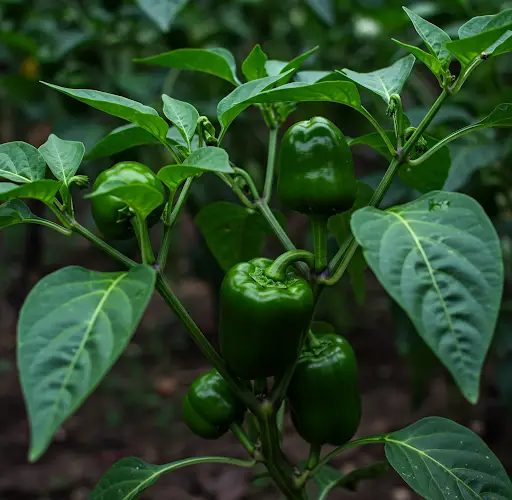Paprika is a favorite plant among many gardeners due to its compact size, relatively low maintenance, and high yield. These vibrant peppers are packed with essential vitamins such as C, K, and A, along with important micro and macroelements. They can be stored fresh for long periods and are excellent for canning. To maximize yield and improve the quality of the fruit, understanding the proper techniques for shaping paprika bushes in both greenhouses and open fields is essential.
Every garden owner dreams of a bountiful harvest. Proper agrotechnology for growing peppers in both open and closed environments includes several important components. These include timely watering, soil loosening, fertilization with mineral or organic nutrients, and pest and disease control. However, alongside these fundamental care practices, there is another crucial aspect to consider—the correct formation of the plant bush.
Maintaining peppers properly, whether in a greenhouse or an open garden, is an agricultural practice that significantly impacts crop production. Many gardeners may overlook the importance of shaping paprika bushes, assuming that simply removing dry leaves and damaged shoots is sufficient. However, the proper formation of bushes brings several advantages. It allows for the removal of infertile flowers and unnecessary shoots that drain the plant’s energy, promotes even ripening of fruits, ensures better sunlight exposure, improves the plant’s structural integrity, reduces the risk of diseases and pests, and enhances the overall appearance of the plants.
Nearly all paprika varieties benefit from bush formation, though some low-growing types with limited foliage may require only minimal pruning. When shaping the shrubs, it is important to maintain a balance. Over-pruning can reduce the plant’s ability to synthesize energy, ultimately affecting fruit production. Therefore, excessive shoots and leaves should be removed in moderate amounts and at appropriate times. It is also important to avoid pruning during wet conditions, as moisture can increase the likelihood of infections. Dry weather is best for such procedures, as it allows wounds to heal quickly and minimizes disease risks.
Three fundamental techniques are used in the formation of pepper bushes: removing unwanted shoots (called “cobwebs”), leaf pruning, and pinching off excess growth. The cobwebs are branches that develop above each leaf along the main stem. If left unchecked, these branches consume energy that could otherwise be used for fruit production. Cobwebs should be removed when they are still small, ideally at a size of 1 to 2 cm.
Gardeners must also decide whether to train the pepper plant on one, two, or three main branches. Typically, two branches are left at the first fork, and each of these branches then produces two additional offshoots. If the goal is to grow a single-stemmed plant, one branch is removed at the fork. However, most growers opt for a two-branch system, as it is more commonly practiced and provides optimal balance. After removing unnecessary shoots, two primary branches should remain at the fork. If a third branch is present, it should be pruned off. The remaining two branches will further develop and require additional thinning to ensure even growth.
When additional offshoots form on the two main branches, it is important to select the stronger of the two and remove the weaker one. For example, if two shoots appear on the left branch, the stronger one is retained while the other is pruned. Similarly, on the right branch, the stronger shoot is kept, and the weaker one is removed. This method ensures proper spacing and promotes healthier growth.
Once the plant reaches five to six leaf levels, it is time to pinch off the tops of each leading branch. This process halts vertical growth, allowing the plant to direct its energy toward fruit development and ripening. Throughout the plant’s lifecycle, periodic removal of excess shoots is necessary to prevent the formation of an overly dense bush.
For those who prefer three main branches instead of two, the same principles apply. All three branches should be guided upward, while unnecessary offshoots are removed at regular intervals. Regardless of the shaping method chosen, the plant requires consistent care, including adequate watering and fertilization. Videos providing detailed guidance on these aspects are available on our channel.
Although not all gardeners use this method of cultivation, shaping paprika bushes is especially beneficial for tall-growing varieties. Without proper formation, the plant becomes a dense, bushy mass, producing smaller fruits that are more susceptible to diseases and pest infestations.
The advantages of properly maintaining pepper plants include:
- A healthier plant that is more resistant to diseases
- Improved airflow around the lower part of the plant, reducing humidity and temperature
- Larger, well-formed, and high-quality fruits that continue to produce throughout the season
In addition to shaping the plant, other essential techniques contribute to successful paprika cultivation. We will be covering these in more detail in future videos. One of the next important steps is learning the correct way to tie paprika stalks for support, so be sure to follow our channel for daily video tips and guidance. By applying these techniques, gardeners can significantly enhance their pepper harvest and enjoy high-quality produce throughout the growing season.



